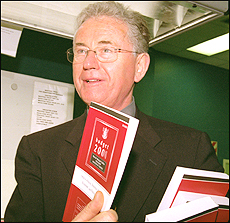



|
 |

|
| No.194 | 9 October 2003 | Essential Information on an Essential Issue |
of key events over the last few weeks. OECD MEETING: TOWARDS MORE AND BETTER JOBS WHAT ARE THE OECD MINISTERS DOING?
TARIFF FREEZE IS OFF POOR FAMILIES LOSE $2 BILLION IN CHILD SUPPORT HOUSING BOOM COSTLY FOR LOW INCOME FAMILIES TEACHER SHORTAGES GLOBALLY WANTED: MALE PRIMARY SCHOOL TEACHERS WRK4U SEMINARS FOR UNEMPLOYED
 LAST Letter
LAST Letter
NEXT Letter   Download this issue as a PDF file
Index to Features
23 September 2003The real hourly earnings of New Zealand workers dropped 6.5% between 1980 and 2001, according to the Canadian Centre for the Study of Living Standards. The Centre has found NZ workers fared worst among workers in all of the 16 OECD countries it surveyed. 24 September 2003In view of rising house prices and falling home ownership, Minister of Housing Steve Maharey is making a bid for more home ownership initiatives in the next Budget. The Green Party calls for a capital gains tax on rental properties. Co-leader Rod Donald says that investors are partly to blame for the current rise in house prices. United Future MP Gordon Copeland calls on the government to end tax breaks for property investors. Minister of Finance Michael Cullen tells a World Bank/IMF meeting in Dubai that the call for an increase of $16 billion in aid was a mere 4%-5% of the total spent on agricultural subsidies by the world’s richest countries. Cullen: “Demolition of these rotten structures will increase the incomes of poorer nations and free up resources in the richer ones to increase aid.” 1,500 new jobs are being created in Melbourne as General Electric redevelops its headquarters and creates an Asia-Pacific employee training centre. 25 September 2003Treasury reports a Budget surplus of $5.6 billion. Statistics NZ reports a national current account deficit of $5.9 billion. The waiting list for families to go into state houses tops 12,000. The NZ Commerce Commission will not oppose the sale of the National Bank by ANZ Bank. 26 September 2003Finsec, the bank workers’ union, believes hundreds of jobs will be lost if the ANZ bank buys the National Bank. Secretary Andrew Cassidy says that previous bank mergers have resulted in between a fifth and a quarter of the staff working for both banks losing their jobs. The ANZ has about 3,700 staff and the National Bank has about 4,600 staff. In Australia, dole payments may be suspended if a beneficiary misses an interview. New rules could see the dole cut off if a person cannot be contacted within four days of failing to attend a Job Network meeting or a scheduled job interview. 28 September 2003IT company EDS is shedding 50 jobs in NZ. EDS has a contractual obligation with the government to generate 360 new jobs by March 2006 as part of its Best Shores scheme. Nelson area construction contractors, desperate for skilled labour, are poaching staff from other firms. Master Builders president Mark Vining says he has heard of tradespeople being enticed away from firms with promises of higher pay and other benefits. Business leaders dismiss the government’s economic development programme as a waste of time and money. A Business Herald survey of 50 business leaders did not generate one positive comment and they rated Jim Anderton’s programme a 3.2 out of 10. Jeans maker Levi Strauss is closing its five remaining North American factories with the loss of nearly 2,000 jobs. Manufacturing will be shifted to a “third-party global sourcing network company.” Unite, the largest North American clothing workers union, blames the Levis closures on the US government’s trade policies which allows firms to “scour the globe for the cheapest, most vulnerable labour”. 29 September 2003The Lincoln University Students Association says the government surplus means that there is no excuse for not implementing a universal student allowance scheme. 30 September 2003The government decides it will end the tariff freeze on clothing, footwear and textiles in 2006. Waikanae-based footwear manufacturer Kushla Buswell says the lowering of tariffs will give her competitors a 9% advantage. Buswell: “It will make it even more enticing for local retailers to buy foreign-made products.” 1 October 2003Desperate employers in the Manawatu are sending a talent scout to South Africa in the hope of recruiting skilled workers. The scout is specifically looking for hydraulic and refrigeration engineers, nurses and carpenters. More NZ’ers are working in higher-paid jobs. The average NZ wage rose by 6.9% over the last year, according to Statistics NZ. 2 October 2003The dearth of midwives has left the Palmerston North and Feilding hospitals eight midwives short. Two English midwives are expected to start next month and MidCentral staff are in Britain trying to recruit more. Forestry company Carter Holt Harvey warns that the high exchange rate is costing jobs. Chief financial officer Jonathan Mason urges the Reserve Bank to lower interest rates, saying the government and Reserve Bank has to understand that when exporters go out of business the jobs won’t necessarily come back when the exchange rates goes down again. 3 October 2003The US announces a rise in jobs in the economy for the first time in eight months.
 LAST Diary
LAST Diary
NEXT Diary 
|
OECD MEETING OF EMPLOYMENT AND LABOUR MINISTERSThe “Towards More and Better Jobs” meeting was held at the OECD headquarters in Paris on 29-30 September 2003 and two-thirds of the member countries sent their Employment or Labour Ministers. Our own Minister of Social Development and Employment Steve Maharey was unable to attend, and New Zealand was represented by government officials Paul Barker of the Labour Market Policy Group (LMPG) of the Department of Labour, and by Neil Martin of the Ministry of Social Development. — The website and background papers for the OECD “Towards More and Better Jobs” conference (Paris, 29-30 September 2003) can be found at www1.oecd.org/subject/elm/index.htm The OECD estimates that, unless action is taken, the annual growth of the workforce in its member countries will slow from an average 1.3% over the past thirty years to 0.3% over the next thirty. In some countries such as Italy and Japan, the labour force will actually decline. And on current trends, the ratio of over 65 yr-olds to the total workforce will rise from 27% in 2000 to 47% in 2030, straining current pension schemes and threatening living standards. The OECD singles out women — mothers and lone mothers in particular — as groups that governments should target to join, or return to, the workforce. It says governments need to pay attention to subsidising childcare and promoting flexibility in working hours. Governments should also look at offering companies tax credits that are conditional on employment or exempting employers from social security contributions if they recruit low-skilled workers.
Sources – OECD website www.oecd.org; OECD Press release17 September 2003 “ Workforce Must Expand and Invest in Skills or Future Economic Growth Threatened, Warns OECD”; Reuters 17 September 2003 “OECD urges labour reforms to fund pension costs” by Paul Carrel Source — OECD Observer No. 239, September 2003TARIFF FREEZE IS OFFFrom July 2006, the highest tariffs — of up to 19% on clothing, textiles, footwear and carpets — will be gradually cut to 10% by July 2009. Rates on other goods will drop by 5% by July 2008. The move is still well short of the APEC target of zero tariffs by 2010. However, Minister of Commerce Lianne Dalziel says that New Zealand could jump to zero tariffs after 2009, but that would depend on what other countries were doing. Robert Reid, from the Clothing Workers Union says New Zealand is mad to lead the way on tariff reduction and should wait until its major trading partners make some concession. He says a World Trade Organisation agreement allows a 37% tariff on textiles, clothing and footwear for New Zealand, and the collapse of the recent WTO talks means there is even less reason for the government to act. Source – New Zealand Herald 1 October 2003 “Govt change opens door to cheap imports” by Ellen Read and NZPAPOOR FAMILIES LOSE $2 BILLION IN CHILD SUPPORTSt John estimates the families of 300,000 children have missed out on the child tax credit because they were unlucky enough to have a parent on a sickness, invalid or unemployment benefit, ACC, student allowance, or NZ superannuation. She says the discrimination is exacerbated by the complexity of the system as many parents, who fall in and out of the benefit system over the year, do not claim their entitlements. She estimates that over the past seven years, these poorest families have sacrificed around $2 billion in lost payments due to this policy. St John: “While not politically fashionable to make the link, it is hard not to conclude that their sacrifice contributes significantly to the current Budget surpluses flowing into the New Zealand Super Fund.” St John contrasts the NZ situation with Australia and Britain, where family support levels are significantly higher and apply universally to all children. The level of support and income eligibility thresholds are also regularly adjusted for inflation. Currently, Australian families can earn $A31,755 before their family tax benefit begins to reduce. And there is a second family tax benefit that provides additional assistance for single income families. St John: “Why is New Zealand such a laggard? Nothing has been done since the 1996 Budget, apart from a tiny crumb of a marginal change in the threshold for abatement of family support in the 2003 Budget. This gave, at most, $1 a week for some children in particular income ranges. In the light of increasing concern about levels of child poverty in New Zealand and its alarming consequences, this lack of action is unfathomable. Families have been told to wait for the 2004 Budget, when they will get a boost to their family payments if the surpluses are large enough.” — “Oz wins hands down on income support for families” by Susan St John (The Independent 24 September 2003) can be read at the Child Poverty Action Group website at www.cpag.org.nz Source – The Independent 24 September 2003 “Oz wins hands down on income support for families” by Susan St JohnWHAT WILL CULLEN DO? Vernon Small, political columnist for The Dominion Post says that calls for better government support for children may indeed be heeded in the next Budget. Minister of Finance Michael Cullen said in his last Budget speech that if last year’s $4 billion government surplus was maintained, and if other conditions were met, he would deliver a $500 million package of assistance to families which would also include incentives to assist people moving from welfare to work. Since that time, the government’s fiscal position has improved with the government tax take up 9.9% on this time last year, and the government’s fiscal position is at a record $5.6 billion surplus. It looks like Cullen’s conditions for a family assistance package will be met. Vernon Small, political columnist for The Dominion Post says that calls for better government support for children may indeed be heeded in the next Budget. Minister of Finance Michael Cullen said in his last Budget speech that if last year’s $4 billion government surplus was maintained, and if other conditions were met, he would deliver a $500 million package of assistance to families which would also include incentives to assist people moving from welfare to work. Since that time, the government’s fiscal position has improved with the government tax take up 9.9% on this time last year, and the government’s fiscal position is at a record $5.6 billion surplus. It looks like Cullen’s conditions for a family assistance package will be met.
Source – The Dominion Post 26 July 2003 “Surplus offers hope for the poor” by Vernon SmallHOUSING BOOM COSTLY FOR LOW INCOME FAMILIESInvestors are pushing up prices for lower-end houses, once regarded as the first step to home ownership, to new heights. Wellington area real estate agent Blair Double says the biggest increase in prices for residential property during the past year was in traditionally cheaper suburbs. Blair: “There is a lot of competition for first home buyers because they are competing against investors. It is getting a lot harder to buy your first home.” Johnson: “The poorest New Zealand households are now not state tenants but private sector tenants depending on inadequate subsidies for their housing. It’s ironic that a government which campaigned on the need to reintroduce income-related rents for state tenants has remained so indifferent to the continuing relative poverty of the three times as many families who continue to rent from private sector landlords.” Alan Johnson recommends that Michael Cullen makes provision in the next Budget for at least $500 million annually for the next decade for a New Zealand Housing Strategy. Johnson argues that in setting its budgetary framework, the government need to give the adequate housing of children the same priority that it presently gives to the future retirement incomes of the baby boom generation.
Source – Weekend Herald 20-21 September 2003 “Cost of crowded houses” by Geoff Cumming; Weekend Herald 27-28 September 2003 “Housing bonanza biggest in 20 years” by Eugene Bingham; The Daily News 25 September 2003 “Property rush prompts calls for govt aid” by Tracy WatkinsTEACHER SHORTAGES GLOBAL TRENDSIn 15 out of 19 OECD countries surveyed, the average age of teachers is increasing and the majority of primary school teachers are over 40 years. In Italy and Germany, almost half of secondary teachers are over 50 ... and in Sweden, Iceland, the Netherlands, Norway and New Zealand, more than a third of the teachers are older than 50 years. A survey of upper secondary schools in 14 OECD countries showed an average of 12% of teaching posts to be vacant at the start of the 2001/2002 school year, and an average of 14% of full-time teachers and 31% of part-time teachers in these schools failed to fully comply with official training and qualification requirements. Science, technology and computer sciences, mathematics and foreign languages were cited as the areas where hiring difficulties were most acute. Source –OECD website “OECD Report Warns of Growing Risk of Teacher Shortages in OECD Countries”; New Zealand Herald 22 September 2003 “World teacher crisis looms, says OECD” by Reuters;WANTED: MALE PRIMARY SCHOOL TEACHERSOne recommendation from the New Zealand Educational Institute (NZEI) is to offer scholarships to men in order to help correct this gender imbalance. But Minister of Education Trevor Mallard is not keen on the idea. Mallard: “My key priority is to have qualified teachers. I am yet to find a parent who would prefer their child be taught by an inferior male teacher rather than a better woman teacher.” Source – Press release New Zealand Educational Institute 22 September 2003; The Marlborough Express 23 September 2003 “Male teachers ‘forced’ to be too PC”; New Zealand Herald 26 September 2003 Editorial “Male staff essential in our schools”
WRK4U SEMINARS FOR UNEMPLOYED NOW NATIONWIDEWRK4U has been piloted since March in three Auckland Winz offices and Associate Minister of Employment Rick Barker says the interim results from the pilots are encouraging. Barker: “The Auckland pilot suggests that the number of people requiring the unemployment benefit from the three sample communities dropped 19% below what was predicted. Early indications suggest that WRK4U is helping clients take on jobs sooner, but it will be some weeks yet before we can ratify that. This is an extremely promising trend ...” Source – Press release NZ Government 18 September 2003 “Govt fast-tracking people into jobs through WRK4U”
|